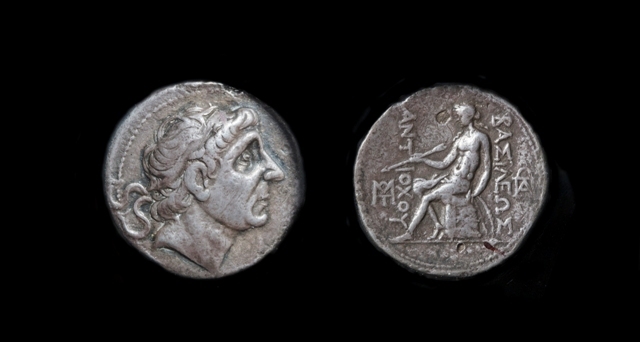Antiochus II, Silver Tetradrachm.
Dublin Core
Title
Antiochus II, Silver Tetradrachm.
Subject
Seleucid Kingdom, Antiochus II (261-246 BCE). Silver Tetradrachm. Seleucia-on-the-Tigris mint.
OBVERSE: In a dotted circle, Antiochus I, in profile facing right, wearing a diadem that ties at the base of his skull.
REVERSE: Naked Apollo sitting on the Delphic Omphalos, looking left down on an arrow, in dotted border. Apollo’s bow is leaning against the right side of the omphalos. Inscription left: "ANTIXOY" (= Antiochou, "of Antiochos"), right: "BASILEWS" (= Basileos, "of the king"). Control-marks: monogram left: MAT, monogram right: APO (?).
OBVERSE: In a dotted circle, Antiochus I, in profile facing right, wearing a diadem that ties at the base of his skull.
REVERSE: Naked Apollo sitting on the Delphic Omphalos, looking left down on an arrow, in dotted border. Apollo’s bow is leaning against the right side of the omphalos. Inscription left: "ANTIXOY" (= Antiochou, "of Antiochos"), right: "BASILEWS" (= Basileos, "of the king"). Control-marks: monogram left: MAT, monogram right: APO (?).
Description
Antiochus II inherited the throne from his father, Antiochus I, when the Seleucid Empire was in the throes of defeat. Pergamum, the victor, was a burgeoning kingdom that would grow over the next hundred years at the expense of the Seleucids. This defeat signaled a weakness that Ptolemy II Philadelphos took advantage of, attacking Seleucid territory in Asia Minor and Syria (Second Syrian War, 260-253 BCE). Accordingly, the early coinage of Antiochus II tried to emphasize the stability of his empire by promoting the image of his father who was known as the Soter or savior. Antiochus I is shown as an older man, with deep-set eyes and highly defined features, just as he was pictured soon after his victory over Celtic invaders, the Galatai, in 276 BCE (the battle in which he earned the title of Soter). The presence of Apollo has double significance. It first references the temple of Apollo at Delphi, which housed the Delphic omphalos, a sacred stone that the Greeks thought of as the “belly button,” or center, of the world. Secondly, Apollo was made the patron god of the Seleucids by Antiochus I, who built a temple to honor the god in Daphne, near the Seleucid capital. Anitochus II had his father deified as Antiochus Apollo Soter soon after his death.
Source
Gift of James and Aneta McIntyre, Hallie Ford Museum of Art, Salem, OR. 206.010.002
Date
ca. 281-261 BCE
Rights
Hallie Ford Museum of Art
Format
2.920 cm
16.100 gr
16.100 gr
Language
Greek
Coverage
This item is on view at the Hallie Ford Museum of Art, in the Mark and Janeth Sponenburgh Gallery.
Citation
“Antiochus II, Silver Tetradrachm.,” Hallie Ford Museum of Art Exhibits, accessed December 20, 2025, https://library.willamette.edu/hfma/omeka/items/show/53.
